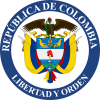Jorge Tadeo Lozano
Jorge Tadeo Lozano | |
|---|---|
Viceroy Pedro Mendinueta y Múzquiz | |
| Preceded by | Nicolás Bernal |
| Succeeded by | Fernando Zuleta |
| Personal details | |
| Born | Jorge Tadeo Lozano de Peralta y González Manrique January 30, 1771 Captain |
| Unit | Walloon Guards |
| Battles/wars | War of the Pyrenees |
| |
Jorge Tadeo Lozano de Peralta, Viscount of Pastrana (January 30, 1771 – July 6, 1816) was a Neogranadine (now Colombian) scientist, journalist, and politician who presided over the Constituent College of
Early life
Born Jorge Tadeo Lozano de Peralta y González Manrique, he was the son of the
Lozano was the quintessential
When Lozano returned to New Granada in 1797, he became an active member of the
Journalism
In 1801, Lozano and his relative José Luis Azuola y Lozano, founded the newspaper Correo curioso, erudito, económico y mercantil de la ciudad de Santafé de Bogotá,[4] the third newspaper in the viceroyalty and in the history of Colombia. This weekly publication ran between February 17, 1801, and December 29 of the same year, with a total of 46 publications.[4] This publication, along with the subsequent newspapers that were circulated at the time, were crucial in the formation of ideas among the criollos, who began propagating an idea of Neogranadine self-administration, governance, economy and culture separate to that of Europe, thus setting the stage for a future separation. Tadeo had the opportunity to publish some of his own articles in the newspaper, mostly dealing with the idea of forming an economic alliance to foment the economy of the viceroyalty.
Lozano returned to journalism again in 1814, when he founded and directed along with José Ángel Manrique the newspaper El anteojo de larga vista, a short lived publication of only 15 issues, but which were filled with a patriotic and independentist sentiment.[5]
Political life
Lozano's first involvement in politics was 1799, when he was appointed
Following the events of the Independence of the New Granada, Lozano offered his services to the cause and became more involved in politics. When
Resignation
Although Lozano was elected president, his term did not last long. He was heavily criticised for being too weak, and for the constant scandals he and his family were involved. His biggest opponent was Antonio Nariño, who waved a propaganda campaign to wean him out of office, all orchestrated and divulged by his newspaper La Bagatela, where he openly called for his impeachment or resignation.[7] This campaign was only the product of a popular discontent with Tadeo, who was criticised by many criollos for his connections with Spain and his title of nobility.
Lozano finally resigned on September 19, 1811, letting Nariño assume office. Afterwards he retired from politics and focused himself to his studies and his personal affairs.
Death and legacy
During the Reconquista of the New Granada, the Pacificador Pablo Morillo invaded Bogotá and ushered the Reign of Terror, the purging of the Independentists and their institutions. Morillo sought out Tadeo, for his involvement in Congress, in the revolutionary newspaper El anteojo, and the fact that he was President of Cundinamarca, made him a prime target of the reign of terror. He was persecuted, his possessions taken away, and was finally arrested and held for two months, which culminated in his execution by firing squad on July 6, 1816, in the Orchard of Jaime, now the Plaza de los Mártires in Bogotá.[8][9]
Lozano is considered a martyr and a hero of the Revolution and Independence of Colombia. His contribution to science, in the areas of Zoology, Botany and expeditions helped cement the basis of science in the education of the country. The Jorge Tadeo Lozano University was founded in his honour.
Personal life
Upon his return to the New Granada, Tadeo fell in love with his niece, María Tadea Lozano e Isasi, daughter of his brother José María Lozano de Peralta, 2nd Marquess of San Jorge. He expressed his desired to marry her, but the
- Jorge Miguel
- Rafael
- Federico
- José
- María Clemencia
- Juan
- Francisca
- Manuela
Titles and styles
Jorge Tadeo Lozano was Viscount of Pastrana, this courtesy title was reserved to the eldest son of the Marquess of San Jorge of Bogotá; the title was originally held by his older brother Jorge Miguel, but ceded it to Jorge Tadeo when he married his daughter María Tadea Lozano e Isasi.[11]
As President of the State of Cundinamarca and Vice-regent of the King's Person, he acted as the
References
- ^ a b c d Rueda Enciso, José Eduardo. "Jorge Tadeo Lozano". Gran Enciclopedia de Colombia del Círculo de Lectores (in Spanish). Bogotá: Biblioteca Virtual del Banco de la República. Archived from the original on July 30, 2018. Retrieved January 3, 2009.
- ^ OCLC 1246712. Retrieved January 2, 2009.
- OCLC 54049933. Retrieved January 2, 2009.
- ^ OCLC 34004781. Retrieved January 3, 2009.
- OCLC 3760744. Retrieved January 4, 2009.
- ^ "Alcaldes Distrito Capital" (in English and Spanish). Alcaldía de Bogotá. Retrieved January 3, 2009.
- ^ Ruiz Martínez, Eduardo (November 1993). "Antonio Nariño, primer presidente con sentido de integración nacional". Revista Credencial Historia (in Spanish) (47). Bogotá: Biblioteca Virtual del Banco de la República. Archived from the original on July 30, 2018. Retrieved January 20, 2009.
- OCLC 1484985.
- OCLC 19590855.
- ^ "Jorge Tadeo Lozano". Real Academia de la Historia.
- ^ OCLC 53958439. Retrieved January 2, 2009.

